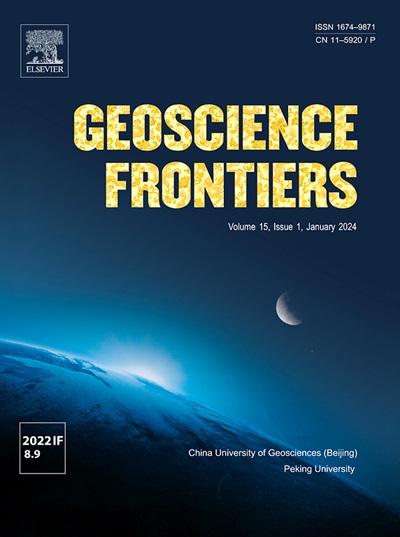我们真的需要钻穿完整的海洋地壳吗?
IF 8.5
1区 地球科学
Q1 GEOSCIENCES, MULTIDISCIPLINARY
引用次数: 0
摘要
我们必须坚持不懈地钻探完整的大洋地壳,以充分解决基本问题,从而完成板块构造理论。主要问题包括:大洋地壳由什么构成,有多厚,地壳-地幔边界(即莫霍洛维奇不连续面或莫霍面)的岩石学性质如何?这些问题听起来可能很天真,因为人们普遍认为这些问题都是很好理解的事实,但事实并非如此。正确地说,我们目前的知识仍不完整,一些流行的误解来自基于简单假设的解释。其中一个假设是,从地震数据推断出的海洋地壳来源于岩浆。测试这一假设是莫霍尔计划(1957-1966 年)的主要动机,该计划试图钻探完整的洋壳,穿过莫霍尔进入地幔。由于成本高昂、工程困难和尝试不足,莫霍尔项目失败了,但所开发的技术使随后的大洋钻探取得了成功。然而,最初问题的答案仍不令人满意。例如,被解释为岩浆起源的地震地壳的全球均匀厚度为 6.0 ± 1.0 千米,但在许多缓慢扩张的海脊段,具有这种厚度的地壳主要是暴露在海床上的蛇纹岩化地幔橄榄岩。因此,必须重新审视关于洋脊岩浆活动的流行观点,这需要对地幔进行完整的洋壳钻探。自 1985 年以来一直为大洋科学钻探提供良好服务的美国 "乔伊德斯决议 "号钻井船将于 2024 年底退役,但中国地球科学界及时希望利用专门建造的 "梦翔 "号钻井船(将于 2025 年服役)继续这一国际努力。国际社会将于 2024 年 11 月 24 日至 27 日齐聚中国广州,就未来几年在何处以及如何成功钻探穿越莫霍面的完整洋壳展开战略讨论。本文章由计算机程序翻译,如有差异,请以英文原文为准。

Do we really need to drill through the intact ocean crust?
We must persevere to drill through the intact ocean crust to fully address fundamental questions towards completion of the plate tectonics theory. The primary questions include: what is the ocean crust made up of, how thick is it and what is the petrological nature of the crust-mantle boundary (i.e., Mohorovičić discontinuity or Moho)? These questions may sound naive because they are widely believed to be well-understood facts, but they are not. Correctly, our current knowledge remains incomplete, and some popular misperceptions come from interpretations based on convenient assumptions. One assumption is that the ocean crust inferred from seismic data is of magmatic origin. Testing this assumption is a principal motivation of Project Mohole (1957–1966), attempting to drill intact ocean crust across the Moho into the mantle. Project Mohole failed because of its high cost, engineering challenges and insufficient tries, but the technologies developed made subsequent ocean drilling successful. However, answers to the original questions remain unsatisfactory. For example, seismic crust interpreted to be of magmatic origin is shown to have globally uniform thickness of 6.0 ± 1.0 km, but crust with such thickness at many slow-spreading ridge segments is dominated by serpentinized mantle peridotites exposed on seafloors. Therefore, the popular view on ocean ridge magmatism must be re-examined, which needs intact ocean crust drilling into the mantle. Drilling at geologically simple sites in the fast-spreading Pacific seafloor is most promising.
The US-led D/V JOIDES Resolution that has well served the scientific ocean drilling since 1985 is to retire by the end of 2024, but timely the Chinese geoscience community wishes to continue this international endeavor using the purpose-built D/V Meng Xiang to be in service in 2025. The international community is to gather in November 24–27, 2024, Guangzhou, China, to discuss strategies on where and how to successfully drill intact ocean crust across the Moho in coming years.
求助全文
通过发布文献求助,成功后即可免费获取论文全文。
去求助
来源期刊

Geoscience frontiers
Earth and Planetary Sciences-General Earth and Planetary Sciences
CiteScore
17.80
自引率
3.40%
发文量
147
审稿时长
35 days
期刊介绍:
Geoscience Frontiers (GSF) is the Journal of China University of Geosciences (Beijing) and Peking University. It publishes peer-reviewed research articles and reviews in interdisciplinary fields of Earth and Planetary Sciences. GSF covers various research areas including petrology and geochemistry, lithospheric architecture and mantle dynamics, global tectonics, economic geology and fuel exploration, geophysics, stratigraphy and paleontology, environmental and engineering geology, astrogeology, and the nexus of resources-energy-emissions-climate under Sustainable Development Goals. The journal aims to bridge innovative, provocative, and challenging concepts and models in these fields, providing insights on correlations and evolution.
 求助内容:
求助内容: 应助结果提醒方式:
应助结果提醒方式:


